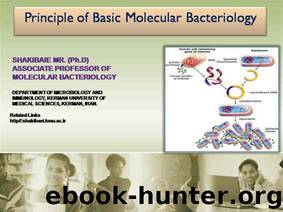PRINCIPLE OF BASIC MOLECULAR BACTERIOLOGY (Introduction to molecular biology Book 1) by Dr. MR Shakibaie

Author:Dr. MR Shakibaie [Shakibaie, Dr. MR]
Language: eng
Format: epub
Published: 2016-04-18T05:00:00+00:00
Plasmids are extra chromosomal DNA which can replicate
independent of chromosome
Quorum Sensing Introduction Bacteria use small molecule signals to communicate with each other. Intercellular signaling at high population cell densities is termed quorum sensing and explains many aspects of bacterial physiology observed in single species cultures entering stationary phase in the laboratory. Quorum sensing is used by diverse species to control a multitude of phenotypic traits that often include virulence factors, bacterial signals , exoenzymes and secondary metabolites e.g., antibiotics and biosurfactants In this review, diversity in the biochemistry and molecular biology of signal production, signal sensing, and signal response are discussed. The elucidation of the roles of quorum sensing in bacterial virulence and in biofilm formation will be used to illustrate experimental approaches commonly used. The understanding of quorum sensing obtained in -vitro will be considered in the light of studies describing the activities of bacteria in the real situations of infection and biofilm formation The relevance of quorum sensing to the activities of bacteria in real situations is discussed, taking into account the role of other bacterial species the host on changes in other nonsignalling, parameters within the environment. Quorum Sensing, Bacterial Signals and Autoinducers Bacteria are able to sense changes within the environment that they inhabit. On perception of change, bacteria are able to respond by altering their phenotype to provide the activities best suited to success in the new environment. The expression of a modified phenotype often relies on new gene expression. In quorum sensing the environmental parameter being sensed is the number or density of other bacteria particularly of the same species, also present. The study of QS in numerous species has led to the concept of the quorate population, which we can define as a population of bacteria that is above a threshold number or density, and that is able to coordinate gene expression and, thus, its phenotypic activities.
QS relies on the production and release of small molecule signals by the bacterium into its environment. These signals have also been termed “autoinducers and bacterial “pheromones.” Put simply, the population grows and more signals is produced until a threshold concentration is reached that the bacterium perceives and responds to, by activating (or sometimes repressing) gene expression. The key properties of a QS system are, therefore is the small molecule signal,
The signal synthase The signal receptor The signal response regulator The genes regulated (the QS regulon)
A good example is the control of bioluminescence in symbiotic populations of Vibrio fischeri within the light organ of the Hawaiian squid, where only above a certain number of bacteria will be able to produce enough bioluminescence to be visible and assist the squid’s hunting The lux genes are contained within divergent transcripts. The luxR gene transcript encodes a protein housing the signal receptor and the signal response regulator. The transcript of the remaining lux genes luxICDABE of the lux operon is activated by LuxR in the presence of the signal, an acylated homoserine lactone N-3-oxohexanoyll homoserine lactone (3-oxo-C6-HSL). The signal is produced by LuxI, encoded by the first gene of the lux operon.
Download
This site does not store any files on its server. We only index and link to content provided by other sites. Please contact the content providers to delete copyright contents if any and email us, we'll remove relevant links or contents immediately.
Deep Learning with Python by François Chollet(12585)
Hello! Python by Anthony Briggs(9922)
OCA Java SE 8 Programmer I Certification Guide by Mala Gupta(9799)
The Mikado Method by Ola Ellnestam Daniel Brolund(9782)
Dependency Injection in .NET by Mark Seemann(9345)
Algorithms of the Intelligent Web by Haralambos Marmanis;Dmitry Babenko(8305)
Test-Driven iOS Development with Swift 4 by Dominik Hauser(7769)
Grails in Action by Glen Smith Peter Ledbrook(7700)
The Well-Grounded Java Developer by Benjamin J. Evans Martijn Verburg(7563)
Becoming a Dynamics 365 Finance and Supply Chain Solution Architect by Brent Dawson(7130)
Microservices with Go by Alexander Shuiskov(6892)
Practical Design Patterns for Java Developers by Miroslav Wengner(6806)
Test Automation Engineering Handbook by Manikandan Sambamurthy(6750)
Secrets of the JavaScript Ninja by John Resig Bear Bibeault(6421)
Angular Projects - Third Edition by Aristeidis Bampakos(6165)
The Art of Crafting User Stories by The Art of Crafting User Stories(5690)
NetSuite for Consultants - Second Edition by Peter Ries(5617)
Demystifying Cryptography with OpenSSL 3.0 by Alexei Khlebnikov(5429)
Kotlin in Action by Dmitry Jemerov(5070)
